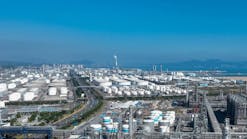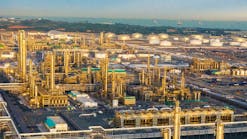Egyptian Refining Co. (ERC) is set to start construction on its long-delayed grassroots refining upgrade project to be built within the existing Mostorod Petroleum Complex (MPC), 20 km northeast of Cairo in Qalyoubia Governate, Egypt.
Construction on the $3.7 billion project, which is designed to address Egypt’s demand for petroleum products and reduce the country’s dependence on imports, is scheduled to begin in late February or early March 2014, ERC’s Chief Executive Tom Thomason recently told OGJ.
Unique undertaking
A joint-development of both the private sector and Egypt’s government, the ERC project includes the construction of a hydrocracking and coking complex within the walls of government-owned Cairo Oil Refinery Co.’s (CORC) 145,000-b/d refinery, the nation’s largest.
Once completed, the hydrocracking and coking plant—which will receive 67% of its feedstock from CORC in the form of fuel oil—will have the capacity to produce more than 4.1 million tonnes/year of refined products, including more than 2.2 million tpy of Euro 5 diesel as well as jet fuel, gasoline, LPG, naphtha, reformate, sulfur, and coke.
The entirety of the plant’s liquid fuels production will be sold to state-owned Egyptian General Petroleum Corp. at international prices under a 25-year off-take agreement, while sulfur and coke production will be marketed to industrial users and suppliers.
In addition to an 80,000-b/d vacuum distillation unit and 40,000-b/d hydrocracker, the project includes a 25,000-b/d delayed coker, a 23,000-b/d naphtha hydrotreater, and a 32,000-b/d distillate hydrotreater.
“It’s a unique and challenging project for many reasons,” Thomason said. “Since it’s an upgrade to an existing government refinery, it won’t be processing any crude oil. That will be done at the refinery and arrive to us in the form of high sulfur fuel oil. Since we’re going to be a coking and hydrocracking plant only, we won’t experience the negative margins for processing crude that a regular refinery typically does.”
Good for all
In addition to becoming Egypt’s first refinery project to produce European specification products, the ERC project also aims to improve environmental as well as social conditions in the region.
“We’re going to be taking atmospheric residue—the high-sulfur fuel oil from CORC that currently can’t be processed any further—to make cleaner-burning fuels,” Thomason said. “That will keep about 93,000 tpy of sulfur currently being burned off into the environment from being released.”
“When we undertook our environmental/social impact assessment (ESIA) back in 2008, it was a relatively new thing to do in Egypt,” Thomason said. “But we wanted to do this right, so that everyone would benefit.”
In addition to financial investments to improvement projects in the communities surrounding the Mostorod refining complex, ERC also is investing in vocational training to equip the people in those communities with employable skills.
“We’ve had a community development team working since 2008 to help establish what I’ve come to call our social license,” Thomason said. “You can get building permits and government licenses, but in the end, you need to have the community’s support for what you’re doing. The contractors we’re already working with and the ones we’re still in talks with already know that, while of course they can bring in their own people, they’ll also be obligated to hire a number of people from our surrounding communities that we’ve worked with in our programs to prepare for jobs at the complex.”
In a recent presentation, the company said that, in addition to services that will surround the project, the ERC project itself will create over 700 permanent jobs. During the construction phase, about 10,000 jobs will be created, according to ERC.
Overcoming setbacks
While discussion as well as initial plans for the project began between Egypt’s government and the private sector as early as 2006 (OGJ Online, Sept. 25, 2006), the 2008 global financial crisis, a 2011 political revolution in Egypt, and ongoing banking challenges in the Eurozone led to delays in advancing any progress towards actual construction.
“When I came onboard in November 2007, things were moving along rather smoothly,” Thomason said. “A lumpsum turnkey contract [for engineering, procurement, construction, commissioning and testing] had been signed with a consortium of GS Engineering & Construction and Mitsui & Co. in August 2007, and we had the original financial close planned for April 2008.”
Just ahead of resolving funding for the project, however, 2008 brought with it the collapse of global economies, which required reorganizing financial backing for the upgrade project. Then, just 3 weeks shy of the next intended financial close in 2011, a Jan. 25 revolution in Egypt left the full amount of financial backing previously pledged by the government no longer viable, according to Thomas.
After the completion of additional financers and with a total of 16 lenders that includes a broad spectrum of international investors, global export credit agencies, and development finance institutions, the EPC project finally reached financial close in June 2012, with $2.6 billion in debt financing alongside $1.1 billion in equity financing.
The road ahead
“We’ve still got some soil remediation to do following the teardown of the last of the old structures at the building site, which we expect to start in the next few weeks,” Thomason said. “We’ll be decontaminating soil and water over the next 3 months, but by the end of February or early March, we’ll see the first pilings go in and real construction getting under way.”
Since the project will be located entirely within the MPC, ERC plans for a smooth construction period given its location.
Despite the political upheaval in 2011, there “have been minimal acts of violence on commercial or government facilities in Egypt,” Thomas said. “We’re located in an urban area with a pipeline hub and storage facilities used by international operators, so it’s well-secured by the Egyptian government.”
With construction on the EPC project scheduled to last about three years, the upgraded plant should be delivering on-spec product by February 2017, Thomason said.
Contact Robert Brelsford at [email protected].

